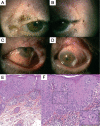Unusually Aggressive Actinic Keratosis of the Eyelid and Conjunctiva
- PMID: 37605896
- PMCID: PMC10461307
- DOI: 10.2340/actadv.v103.4500
Unusually Aggressive Actinic Keratosis of the Eyelid and Conjunctiva
Conflict of interest statement
Figures


References
-
- Werner RN, Sammain A, Erdmann R, Hartmann V, Stockfleth E, Nast A. The natural history of actinic keratosis: a systematic review. Br J Dermatol 2013; 169: 502–518. - PubMed
-
- Richard MA, Amici JM, Basset-Seguin N, Claudel JP, Cribier B, Dreno B. Management of actinic keratosis at specific body sites in patients at high risk of carcinoma lesions: expert consensus from the AKTeam of expert clinicians. J Eur Acad Dermatol Venereol 2018; 32: 339–346. - PubMed
MeSH terms
LinkOut - more resources
Full Text Sources

